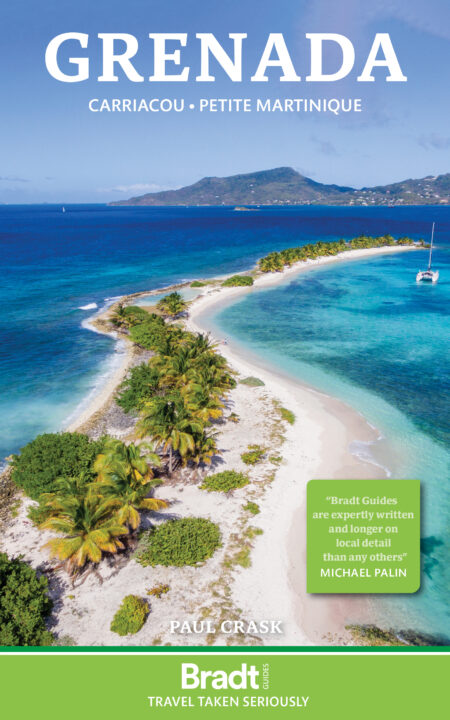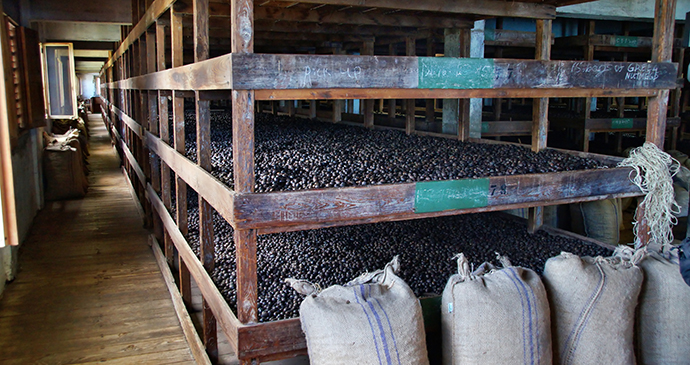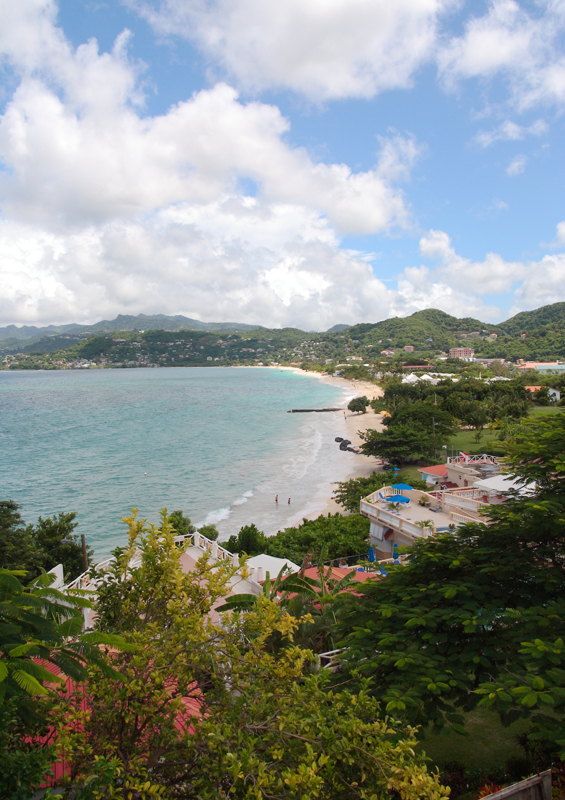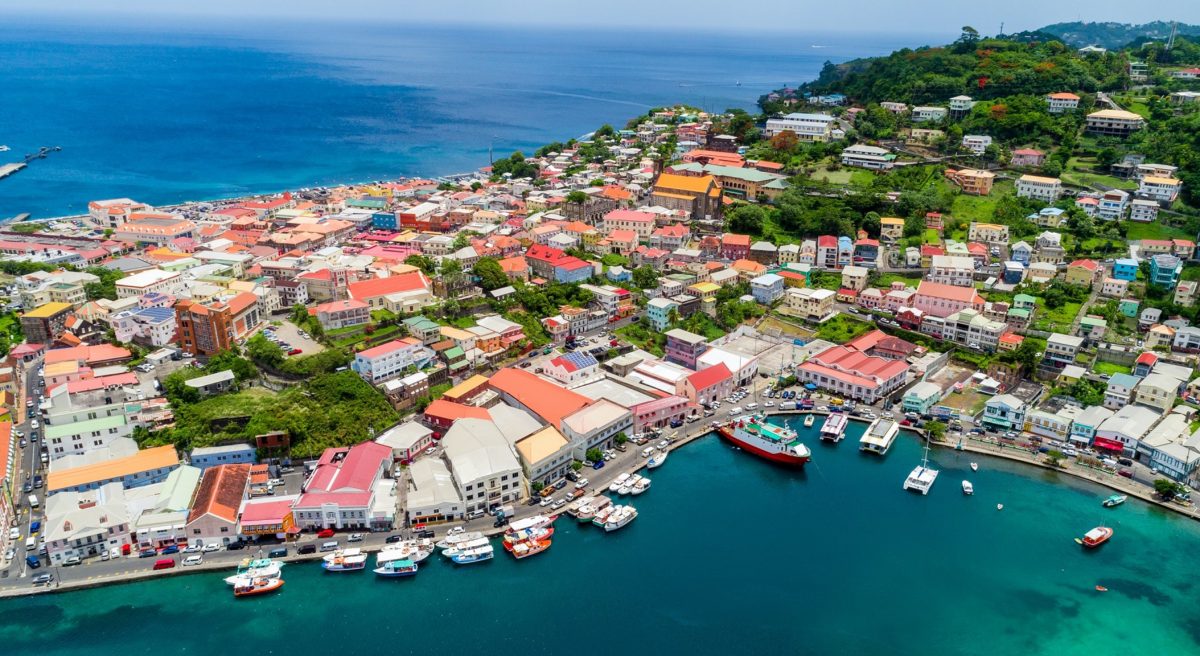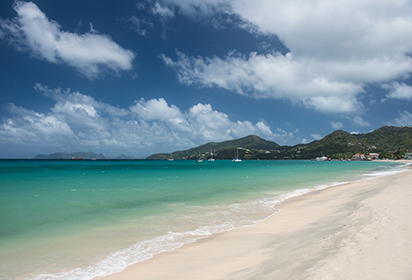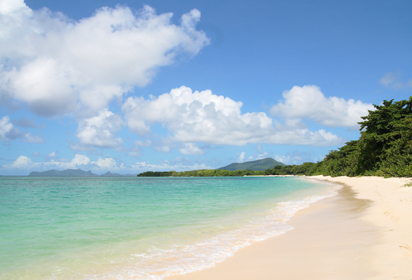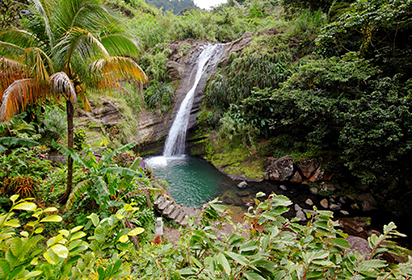Going beyond the loungers and the beaches and engaging with a destination’s friendly, interesting people is a dimension of travel that I think we often neglect, but it enriches our journeys and makes them far more rewarding. Grenada is the perfect place to make new friends and discover new places.
Paul Crask author of Grenada: The Bradt Guide
Grenada is one of our hot destinations for the year ahead – check out the full list of the best places to travel in 2024 here.
Grenada is a Caribbean country with everything; stunning white sand beaches, mountains and rainforest, a vibrant cultural heritage, and some of the best yachting facilities in the region. A holiday to this tri-island nation is a trip with spice – literally. One of the world’s largest nutmeg and mace producers, its organic cocoa crops are the key ingredient of some of the best chocolate you have ever tasted.
A little further north in the adorable Southern Grenadines, Carriacou and Petite Martinique are diminutive islands that feel adrift from the world. Peaceful and laid back, they retain a strong cultural heritage of boat building, maroon and saraca festivals, and the famous Big Drum Dance.
Travel to Grenada to meet some of the loveliest people on earth, stay in a luxury beachside resort, holiday cottages or aboard a charter boat. Scuba dive scores of shipwrecks – including the largest in the Caribbean – hike volcanic ridges and peaks, eat traditional oil-down and drink rum from one of the region’s oldest distilleries. Whether you are here for sunsets or a bit of spice, Grenada has it all.
For more informaton, check out our guide to Grenada
Food and drink in Grenada
Archaeologists and anthropologists believe Grenada’s original settlers would have survived on a diet of local seafood and animals they brought with them in their canoes as they moved north along the Lesser Antillean island chain from South America.
As time passed they would have cultivated crops such as sweet potatoes, yams and cassava. European settlers brought bananas, breadfruit, mangoes, plantain, cocoa, sugar and spices, and their west African slaves would have combined all these ingredients to make simple one-pot soups or stews that were heavily seasoned and cooked over open fires.
Caribbean Creole is a culinary style that emerged from the heritage of the islands during European occupation and the slave trade. Those islands that continued to have a strong French influence after emancipation would have developed French Creole cuisine.
Other islands, such as Grenada, where stronger influences came from indentured East Indian immigrants, Trinidad and Tobago, and the British plantocracy, would have taken a slightly different path and developed their own unique style of Caribbean Creole cooking.
Today, traditional Grenadian cuisine still includes many customary ingredients and is often cooked outside, over an open fire, and in a single pot. You will find authentic, great tasting and very reasonably priced local dishes in many of the islands’ smaller and sometimes more remote eateries and roadside snackettes.
World-class international dining has become a by-product of Grenada’s burgeoning tourism industry, with its luxury resorts, hotels and sailing regattas. Visitors will find a good selection of restaurants offering various culinary styles and fine-dining experiences that suit all pockets and tastes, including, of course, traditional Grenadian.
Local dishes
Grenada’s national dish is called oil-down. It is a simple, one-pot dish that is often cooked over an open fire or on a traditional coal pot. Typically its ingredients include a combination of provisions such as breadfruit, yams, tannia, green bananas and dasheen, flavoured with meat such as pork or beef, and then cooked in coconut milk and spices until the liquid boils right down to leave only an oily residue remaining.
Both international and local restaurants offer oil-down occasionally on the menu, though it is usually eaten as a picnic or festival dish outdoors. Another very traditional dish with coconut as a key ingredient is coucou. This dish is thought to have its roots in west Africa and is made from cornmeal flour, seasonings and coconut milk. The ingredients are mixed in a large pot over a stove or open fire and continuously stirred, or ‘turned’, until the mixture thickens. It is often eaten with fish and in Carriacou traditionally blended with pigeon peas.
Calalou is frequently used to describe dasheen, a ground provision whose young leaves are cooked as a vegetable similar to spinach, or alternatively as the basis of calalou soup, a very common Caribbean Creole dish. Calalou soup is often served with crab and is a seasonal speciality. Land crabs are also used in the preparation of another favourite dish, crab backs. The crab’s flesh is mixed with a combination of spices and seasonings and then stuffed back into the shell, sprinkled with breadcrumbs and baked in a hot oven.
Given Grenada’s strong fishing heritage, seafood features prominently in local cuisine. Lambie is the queen conch (Strombus gigas) and has been eaten in Grenada ever since the first settlers landed there. It is a seasonal dish and is usually served stewed, fried, curried, or in a Creole sauce. The discarded, cleaned and polished conch shell is often sold in souvenir and gift shops and is also traditionally blown by fish vendors to let people know their catch is for sale.
Conch is found in shallow waters with sandy beds and caught by free divers. According to conservationists, conch is the victim of overfishing throughout the Caribbean. Titiwi is a juvenile goby that is caught in nets at the mouths of rivers at certain times of the year. The fish are eaten whole, usually in a seasoned fritter, often known as a titiwi cake or titiwi ackra.
Fish caught by local fishermen and also common in local cuisine are tuna, bonito, marlin (known locally as ocean gar), flying fish, jacks, and dorado, also known by many as mahi-mahi or dolphin fish, and by locals simply as dolphin. Lobster is a seasonal catch and many restaurants will offer it on their menus. A great place to try out some lobster or other delicious local fish dishes is at Gouyave’s Fish Friday which is held every Friday evening from around 19.00 in the heart of the town.
The influence of East India is evident in curried food, such as curried goat, as well as the very popular roti. The latter is a dish made of a flat bread that is stuffed with a mixture of curried vegetables, chicken or fish. It is an inexpensive and tasty dish that is very filling. Roti connoisseurs should note that quite a number of local eateries in Grenada may serve chicken rotis with bones. You may therefore wish to ask before you order.
Vegetarians should have few problems finding good food to eat in Grenada. As well as a number of vegetarian eateries, many restaurants will have vegetarian options on the menu. Rice and peas, fried plantain, roasted breadfruit, boiled or stewed provisions, grilled corn, pumpkin soup and calalou are all common local dishes.
Local drinks
Non-alcoholic
Tap water is safe to drink on all three islands though most supermarkets, convenience stores and hotels will sell bottled water. Glenelg Natural Spring Water is Grenada’s local product, and is available island-wide. Mauby is the name of a drink that is made from the bark of the mauby tree (Colubrina elliptica). The bark is boiled with spices and sweetened with sugar to produce a concentrated syrup that is diluted with cold water. T
he drink is an acquired taste and can be a little bitter. Freshly made fruit juices are widely available in Grenada and your choice is usually based on what is in season. Golden apple, mango, pineapple, guava, passionfruit, orange and grapefruit are all common juices and are very refreshing
Alcoholic
The signature drinks of the Caribbean are rum and rum punch, and Grenada is no exception. With three distilleries producing a range of high-quality rums, connoisseurs are quite spoiled for choice. Clarke’s Court Estate produces a great range of blended rums and rum punches including the very popular Old Grog. Westerhall Estate also has a nice selection of blended rums, including its fabled Jack Iron.
The River Antoine Estate is an amazing place. One of the oldest distilleries in the Caribbean, it claims to have been working non-stop since the 18th century and is still using the same machinery and processes. Pure cane rum is produced from the sugarcane that is cultivated on its own estate. Its Rivers rums are also a very popular range. Carib is Grenada’s local lager beer and is brewed in the southwest, near Grand Anse.
Health and safety in Grenada
Health
Before you go
The only immunisation requirement for visitors to Grenada over one year of age is a yellow fever vaccination certificate if you are arriving from a yellow fever infected area. The vaccine is not suitable for everyone so this should be discussed with a health care professional experienced in giving it. Grenada doesn’t have malaria and the water is usually safe to drink, however, it is still wise to drink bottled water and avoid ice. It is recommended that standard vaccinations such as tetanus, diphtheria and polio, which comes as an all-in-one vaccine (Revaxis), are up to date, and travellers may also wish to consider protecting themselves from hepatitis A.
Rabies is endemic in Grenada but is only usually a problem for those staying for extended periods or working with animals. It may be present in any warm-blooded mammal and is spread through the transfer of saliva from a bite, a scratch or a lick over broken skin. It is more commonly found in the mongoose population. You will see this animal quite often in rural areas – it was introduced here and has no natural predators – but it is a shy creature and will usually run away. Beware of those that are not shy, that stand their ground or demonstrate aggressive behaviour. If you are likely to be living or working in rural areas for a long period you should consider getting a pre-exposure rabies vaccine which consists of three doses given over a minimum of 21 days. Whether or not you have had the vaccine you should scrub the wound with soap and running water, apply an antiseptic and get yourself to medical help as soon as possible. Visitors requiring health care in Grenada are required to pay upfront for treatment. Medical insurance is usually a good idea, particularly if you will be participating in activities such as hiking or scuba-diving.
Travel clinics and health information
A full list of current travel clinic websites worldwide is available on www.istm.org. For other journey preparation information, consult www.travelhealthpro.org.uk (UK) or http://wwwnc.cdc.gov/travel/ (US). Information about various medications may be found on www.netdoctor.co.uk/travel. All advice found online should be used in conjunction with expert advice received prior to or during travel.
Safety
Grenada is a safe country for visitors and precautions you should take when visiting Grenada, Carriacou and Petite Martinique are no different from those you would take travelling anywhere else in the world. It is usually very safe to walk around, both by day and by night.
Most people are very friendly and helpful. There are few reported incidents of visitors experiencing crime though you should apply common sense precautions such as not flaunting wealth openly, dressing conservatively, and avoiding conflict.
If approached by people asking for money, either give them a dollar or two, or politely decline and walk on. Do not lose your temper or decide to give someone a lecture. It is simply not worth it and it will ruin your day. It is not uncommon for locals to admonish people they see hounding visitors for money. If you do find yourself in a threatening situation your focus should be on getting through it as peacefully as possible and not fighting back.
Female travellers
Inevitably as a visitor you will attract attention – whatever your gender. You are the subject of possible friendship, a link to the world beyond the confines of life on the islands, and a potential source of income – however short term. This attention should not, however, be misinterpreted as a threat. As mentioned, Grenada is a very safe place and women travelling alone need only take the same, common sense precautions they would at home.
Certainly women travellers are generally more vulnerable to theft or unwanted attention than men, but this should not prevent you from exploring and enjoying the freedom of these beautiful islands. If you can, you should avoid going to remote places alone, both by day and by night, try to dress as conservatively as your taste in fashion will allow, and do not sunbathe topless. You could consider carrying a flashlight at night and trying to blend in as much as you can. Wearing similar clothing to local people is one way of doing this, as is not wearing ostentatious jewellery.
If you do attract unwanted attention from amorous men, be as polite and good humoured as possible in the way you express your wish to be left alone. Try to extract yourself from the situation as quickly as you can, avoid conflict, resist becoming angry and do not try to humiliate or belittle those you feel are harassing you. Some recommend wearing dark sunglasses as this helps you to avoid eye contact and may also enhance your confidence.
Travellers with a disability
Grenada is not especially disabled-traveller friendly. Many hotels do not make special provision for wheelchair access, some are located on steep slopes and have lots of steps, and public buses are predominantly the small minibus type. Nevertheless, with a little research and planning, it is possible to work your way around these obstacles.
Several of the hotels along Grand Anse Beach have hotel rooms and self-catering facilities on ground-floor level, and access to the resorts themselves is flat and just a short distance from the main road. The Grenada Grand Beach Resort, the Coyaba Beach Resort and the Spice Island Beach Resort are three examples.
The Calabash at L’Anse Aux Epines is also a good option, as is Lance Epines Cottages. In terms of sightseeing, there are many private bus- and taxi-tour operators and your hotel may also be able to arrange something specific to your needs.
In addition to driving tours, sites and attractions that are accessible by wheelchair include: River Antoine Rum Distillery (most parts), Belmont Estate (there is a slope, but the immediate area around the boucan, drying sheds and museum should all be fine), Concord Waterfall (viewing the first waterfall), Annandale Waterfall (the path is flat and paved most of the way) and Gouyave Fish Friday (though the streets are narrow and can be crowded). Boarding and disembarking the Osprey ferry between Grenada, Carriacou and Petite Martinique is certainly not wheelchair friendly; indeed anyone with significant manoeuvrability challenges will probably find this very difficult.
Travelling with children
Travelling with children is certainly not a problem in Grenada and most hotels and self-catering accommodations welcome families. Nice beaches with calm waters include Morne Rouge, L’Anse Aux Epines and Paradise Beach on Carriacou. The Grenada Grand Beach Resort is located on Grand Anse Beach and has excellent facilities for family holidays including a large ‘fantasy pool’, man-made waterfalls and a wide selection of adventure packages such as snorkelling, boating and kayaking.
Children will enjoy the natural waterfalls at Concord and Annandale, both of which are easily accessible, and the Belmont Estate should provide lots of interest for cocoa and chocolate lovers. Other outdoor activities that are fun for families include river tubing (check minimum age limits with operators), turtle watching and hiking – the St Margaret’s Falls (sometimes referred to as the Seven Sisters Falls) is a good pick and an adventure you are sure to talk about into the evening.
If you are travelling with infants you will find baby products in the Spiceland Mall in Grand Anse as well as the pharmacies in St George’s. As they are imported, they can be quite expensive, however, so you will need to balance cost with convenience when planning your trip and deciding what to bring with you from home.
LGBTQ+ travellers
The Roman Catholic church is the predominant religion on the islands and so majority views on homosexuality are in accord with church doctrine. Like many of the Caribbean islands, homosexuality in Grenada has not been decriminalised though in recent times there has been increasing international pressure to do so with aid funding tied to human rights. Grenada’s homosexuals are therefore forced to maintain a low profile and are unable to express their sexuality openly and without prejudice. However you choose to deal with this is your choice, of course. But you should be aware that overt displays of your sexuality will certainly draw attention, and responses will be unpredictable in nature.
Travel and visas in Grenada
Visas
All visitors to Grenada must be able to present a valid passport and a return or an onward ticket. Visitors from the UK, US, Canada, Commonwealth countries, EU countries, Caribbean countries, Japan, Norway, and Israel do not need a visa.
There is no departure tax on leaving Grenada’s Maurice Bishop International Airport. Unlike on some other islands, the tax has been built in to your ticket. Travellers departing Lauriston Airport in Carriacou and connecting to an international flight the same day must pay a departure tax of EC$60. If you are flying from Lauriston and staying in Grenada then you must pay a departure tax of EC$10.
Getting there and away
By air
Grenada’s Maurice Bishop International Airport services flights to and from the United Kingdom, the United States, Canada and the Caribbean. The airport is located in the southwest of Grenada and is very close to the large resorts and beaches of Grand Anse.
By sea
Cruise ship
Grenada is visited by several cruise lines. The cruise-ship terminal is located in the capital, St George’s, where two ships are able to put in at the same time. Additional ships either berth at the port or in St George’s Harbour where passengers are transported by tender to the cruise-ship terminal. Cruise prices vary according to time of year and cabin type, and schedules are also subject to change. When booking cruises, you have the option of choosing shore excursions in advance.
Private yacht
Visitors to Grenada, Carriacou and Petite Martinique arriving by private or charter vessel should notify authorities within two hours of arrival at one of the following ports of entry: Grenada Marine, Grenada Yacht Club, Grenville Harbour, Hillsborough (Carriacou), Le Phare Bleu, or Prickly Bay Marina. A clearance form can be downloaded from the internet and you must purchase a cruising permit which is valid for a month and allows you to sail Grenada’s waters unrestricted. Other documentation requirements include: three crew and/or passenger lists; immigration cards for crew members and passengers landing; ships, stores and health declaration; a port clearance from the last port of call; a valid passport for all crew and passengers. Grenada uses the Red Right Returning Rule.
Getting around
Getting around Grenada, Carriacou and Petite Martinique is relatively straightforward. The public transport system of buses is very efficient and inexpensive and taxis are widely available. Without doubt the most convenient and flexible way to explore the islands, however, is by rental car. Both Grenada and Carriacou have a good selection of car-hire firms.
By bus
Grenada has an excellent bus system. It is very convenient, affordable and extremely reliable. The only real downside is that many buses tend to stop operating after around 19.00 on most days and are very scarce on Sundays.
The bus system is straightforward. Almost all bus routes start and finish at the bus terminus on Melville Street. The terminus is very easy to find. It is a busy and noisy place, yet deceptively well organised, with droves of buses seeming to arrive and depart in an orderly fashion. The buses are the minibus variety and can be identified by the prefix H on their number plate as well as the route number and destinations printed on the front windscreen.
Many drivers also have their own colourful slogans, nicknames or mottos plastered on both front and rear windows. Some bus drivers may be accompanied by a ‘conductor’ who makes appeals to potential passengers and collects money. Where there is no conductor simply pay the driver at the end of your trip. Catching a bus is great value for money and fares will rarely top EC$10.
There is an ‘off-route’ system that takes in the beaches, hotels and bays of the southwest peninsula and is a little more expensive. In Carriacou, the buses follow the same system, beginning and ending their routes at the terminus in Hillsborough. There are no buses on Petite Martinique.
By taxi
Grenada’s taxi drivers are licensed by the government and should prominently display their official credentials. The price of journeys from Maurice Bishop International Airport are fixed but in other places you should agree the fare before getting into the taxi. Many taxi drivers will also offer island tours, and fares are negotiable. Be sure you are clear on the fare before you set off and that you know whether the dollar price quoted is US or EC.
Car hire
You have a good choice of car-hire companies in Grenada and Carriacou. The most common cars are small 4×4 vehicles. Prices vary according to car type and season but are on average between US$50 and US$70 per day with discounted rates usually offered for longer periods. Collision damage waiver is often an additional cost – please ask. Many hire companies offer free drop-off and pick-up at the airport and hotels. Check the car over very carefully before signing your rental agreement. Look for scratches and bumps, test lights and brakes, examine tyre tread and make sure any bodywork defects are properly recorded.
If the vehicle has poor tyre tread, request replacements. If the car handles poorly when driven, return it and request a replacement straight away. Do not settle for something that feels or looks wrong. Grenada has very steep and winding roads, some along high cliffs. If you are exploring the interior, you may also have to drive along rough, perhaps muddy vehicle tracks. Be sure you are happy with your car before driving off.
The Grenada government requires the purchase of a visitor’s temporary driving licence. This costs EC$60 for a three-month licence and is either obtained from the car-hire company itself or from a local police station (if the latter is the case the rental company will take you there). In order to hire a car and purchase a visitor’s licence, you must be able to present either your domestic or international driving licence, so make sure you bring it on holiday with you.
Water taxi
An interesting, fun and often quite wet way to either explore or simply get from A to B is to take a water taxi. A ride on one of these colourfully painted wooden motorboats can cost as little as US$5 or as much as US$100; it all depends on where and how far you would like to go. During the cruise-ship season water taxis make frequent runs between the cruise-ship terminal and Grand Anse Beach. Simply follow the signs to the water taxis in the Esplanade shopping mall. Prices are usually on a per-person basis. Th ey also operate from the Carenage in St George’s.
Water taxis may also take you further afield to other beaches or to off shore islands. Some of these trips may include a spot of fishing and a barbecue on the beach. They can be great fun. Many hotels can set you up with water taxis that they recommend. Alternatively you can simply look for one and negotiate. Very few actually advertise, however.
In Carriacou water taxis can take you to Sandy Island, White Island, Petite Martinique, or even further afield to places like the Tobago Cays, five beautiful desert islands that belong to St Vincent and which were a location for the film Pirates of the Caribbean.
Hitching
Hitching a ride is common in Grenada and, if your budget is very tight, or if buses do not operate along your planned route, it is an inexpensive way to get around. You will often see people trying to get a ride, especially on Sundays and in the evenings when fewer buses operate.
Hitching may involve long waits, of course, sometimes in heavy downpours, but together with travelling by bus, it is a nice way to meet local people and experience a part of their lives and their island that may not be possible in other circumstances.
When to visit Grenada
For both stay-over and cruise ship visitors the most popular time to visit Grenada is between November and June. Although there is always the chance of a passing shower and the peaks of the interior may be damp and hidden by clouds, this is the dry season and sunny days are practically guaranteed. The islands are busier, accommodation more expensive, and restaurants are quite crowded, but it is a lively time and there is usually a lot going on. By May and June the cruise-ship season has petered out, popular attractions are less busy, and the skies are usually clear and blue. If you prefer less hustle and bustle, but still crave back-to-back sunny days, then this is a good time for you.
If festivities are your thing then the carnival seasons (February in Carriacou and August in Grenada) offer around the clock parties, street parades, traditional ‘jump-up’, carnival queen and calypso competitions. The Carriacou Maroon & String Band Festival and numerous sailing regattas attract plenty of culture vultures and boating enthusiasts.
The wet season runs from July to December and the Atlantic hurricane season usually peaks in early September. A common misconception of the hurricane season is that Caribbean islands are constantly bombarded by them. Fortunately this isn’t true, but the threat of occasional tropical depressions, storms and hurricanes is real enough from July all the way through to the end of October. For much of the time the weather is hot and humid. Rainfall usually comes in short but heavy waves and can be expected on a daily basis. At this time of the year accommodation prices are much lower and the island is very quiet. Some hotels may close during September. The low season can actually be a nice time to explore the islands but you have to be prepared, both physically and mentally, for rainstorms to disrupt your plans.
Events calendar
January
Get out on the water
The Port Louis Grenada Sailing Festival and the Spice Island Billfish tournament keep both ‘yachties’ and sport fishermen entertained this month.
February
Serious family sailing
Although the South Grenada Regatta has some serious sailing competitions, it’s very much a fun-filled family event hosted by Le Phare Bleu on Grenada’s south coast.
March
Look out for jab-jabs, moko jumbies and shortknees
You’ll meet all these characters and more at the annual Carriacou Carnival on the Monday and Tuesday before Ash Wednesday.
April
Drums, music and dance
Head up to Carriacou during April for the annual Carriacou Maroon and String Band Festival.
May
A great time to dive
With the cruise season drawing to a close, everywhere is a little less crowded. Take the opportunity to scuba dive some of Grenada’s wrecks with one of the operators on Grand Anse Beach.
June
Happy Birthday in Gouyave
It’s the annual Fisherman’s Birthday festivities in the west coast village of Gouyave. Along with its weekly Fish Fridays, Gouyave justifiably has a reputation for being a party town that never sleeps.
July
Heritage sailing
Yes, it’s time for even more fun on the waves with the annual Carriacou Regatta. It’s a great chance to see what the boat building heritage is all about.
August
‘Jump up’ in St George’s
Main island Grenada holds its colourful Carnival celebrations every August, so don’t miss a chance to get in on the action!
September
Time for a cook up and an oil down
At the heart of the hurricane season things are a little quiet on the islands. But don’t let that stop you from eating some great food at the annual Grenada Culinary Fest.
October
Remembering the past
Thanksgiving Day on 25th October is a time when Grenadians remember the revolution and the US military intervention that followed.
November
Get into the mountains
With the hurricane season over, this is a great month to get out and do some hiking. Have you ever climbed Mount St Catherine, the island’s highest peak? Grenada’s oldest hiking guide, Telfor Bedeau, is in his 70s and has done it hundreds of times, so no excuses!
December
Sing about your neighbours
Just before Christmas, the Carriacou Parang Festival is when islanders take to the streets of Hillsborough and sing songs they have written about local scandals and gossip. It’s just about the most unusual festival you’ve ever seen!
What to see and do in Grenada
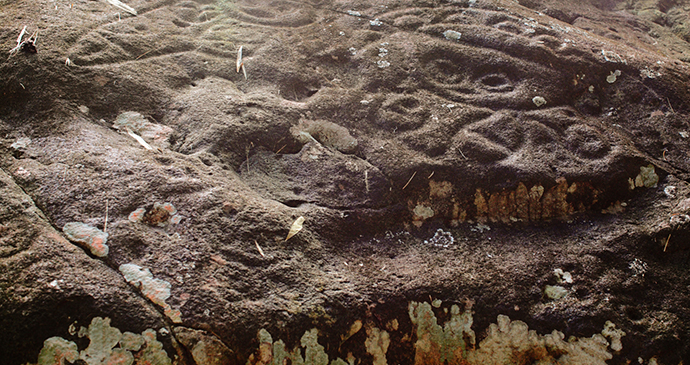
Amerindian petroglyphs
Petroglyphs are images that have been etched into rock and are found all around the world, created by many different people from a range of historical eras. Grenada’s petroglyphs are believed to have been carved by the island’s earliest Amerindian peoples and are found at several sites in the north. The best known are those at Duquesne and Mt Rich. Mt Rich is on the road between Sauteurs and Hermitage.
Though we can only speculate on their meaning, most scholars believe the images relate to gods or mythical figures, and some speculate that, as many are discovered near water, they may perhaps have some symbolic meaning – perhaps during periods of drought.The elaborate carvings appear to depict figures, faces, and even monkeys, which appear in ancient myths.
The Mt Rich petroglyphs are carved on a large boulder now upturned at the bottom of a steep but narrow valley where the St Patrick River flows. There is no sign and it is hard to believe that such an important piece of Grenada’s heritage appears to have been abandoned in this way. At a large road junction a little to the north of Mt Rich look for a peach-coloured bus shelter and a green-painted house. The only way down to the river is via the private garden so please give the owners a shout and ask for permission. Some rough steps run down the side of the house and through the garden. They are quite steep but it isn’t far. When you reach the river, head to your right (you will probably have to wade a bit) for about 5 minutes until you come to the boulder. The river is shallow, but you may have to negotiate fallen branches and other debris. You can’t miss the boulder. The carvings are very impressive and it is awesome to witness something that was created such a long time ago, for reasons we do not understand, by the indigenous people who came to live here from the South American continent.
At the southern end of Duquesne Bay are more accessible examples of Grenada’s Amerindian petroglyphs, though they are in poor condition, unfortunately. Duquesne Bay is located on the west coast road to the north of Victoria, at the point where the road turns inland towards Sauteurs. When you get down to the beach (you can park by the fishing boats and concrete buildings), simply head left all the way along the sand to the rock face at the far end. On my most recent visit I met a very nice fisherman who proudly declared that it was his job to care for the petroglyphs. Though by no means an expert on the subject, I do feel that scrubbing them with detergent and sea water on a daily basis may not be the best method of preservation. The carvings are far less visible than on my previous visits and the site is clearly in a state of decline.
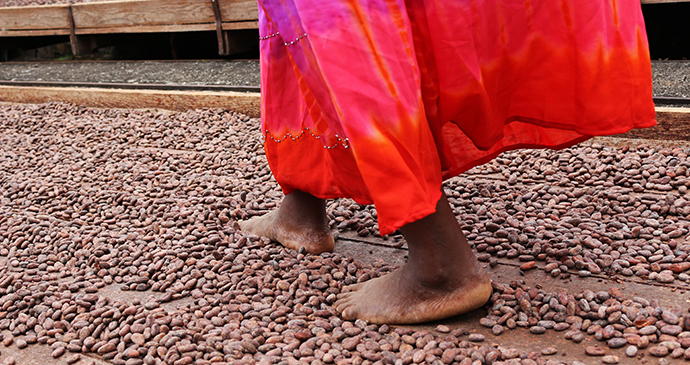
Belmont Estate
Belmont is a historic estate that dates back to the late 1600s when the first French settlers arrived on the island. The estate was a large coffee and sugar producer before changing over to nutmegs and cocoa in the 1800s. Described as an ‘agri-tourism product’, the 400-acre Belmont Estate successfully fuses agriculture, history, chocolate-making, and culture to produce a business and heritage site that should be on every visitor’s agenda. Don’t miss it. In addition to tours of the cocoa harvesting, sweating, and drying process, there is a picturesque tropical garden, a plant nursery, a gift shop, an organic farm, animals (including morocoy, mona monkeys and macaws), an organic goat dairy, café and a restaurant that serves excellent local cuisine. There are also occasional cultural events such as ‘dancing the cocoa’ and drumming. ‘Dancing the cocoa’ is an interesting spectacle where two estate workers, a man and a woman, dance together in a large copper pot of cocoa beans. After cocoa has been dried, the beans sometimes have a white residue on them – a natural result of the fermentation process, but one that makes them less visually appealing to discerning international customers. Before the advent of special polishing machines, dried cocoa was placed in large copper pots and a couple would ‘dance’ on them to the beat of a drum. The outcome is a couple of exhausted dancers and some very shiny cocoa.
It is indeed the cocoa and the chocolate that really capture the eye, the nose, and the imagination at Belmont Estate. Now entirely organic, the estate grows and supplies cocoa to its own chocolate factory.
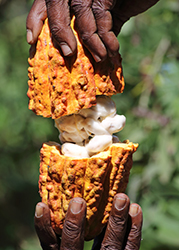
(Native to the Amazon region, the cacao tree is believed to have been introduced to Grenada in the 17th century © CKP1001, Shutterstock)
Belmont Estate’s other attractions include a goat dairy and farm. Over 100 thoroughbred goats roam the estate’s upper paddock and their milk is used to produce a delicious, light organic cheese. Other animals cared for here, and frequently visited by local schoolchildren, include tortoises (known locally as morocoy), mona monkeys, donkeys and macaws (a conversation or sing-song with ‘Rainbow’ is an entertaining experience).
End your cocoa and chocolate experience at the large, open-sided Belmont Estate restaurant where great food is served from coal pots. You can also purchase other delicious Belmont Estate-branded products such as jams, jellies and chutneys.
Support and learn about Grenada’s nutmeg industry with a tour of the Gouyave Nutmeg Pool © Przemyslaw Skibinski, Shutterstock
Gouyave Nutmeg Station
The nutmeg processing station at Gouyave, referred to by local people as ‘the pool’, is located in the centre of the village on the coastal side of the road, just south of the bridge to L’Anse. Owned by the Grenada Co-operative Nutmeg Association, it is one of three processing stations in Grenada. It was constructed in 1947 on the site of a former coastal battery that was built by the French in the 1700s to protect this west coast settlement from attack and invasion.
The co-operative was formed in 1952 with the aim of removing the monopoly of nutmeg processing, sales and export from the plantation owners. Farmers who are members of the co-operative agree to sell their produce exclusively through the co-operative. In its heyday Gouyave would process up to 2,700 tonnes of nutmegs per year for export. The impact of Hurricane Ivan devastated the industry, however, and today Gouyave is the only station on the island still processing nutmegs for domestic consumption and export. Despite this serious setback, the Gouyave station is a fascinating place, nutmeg processing is recovering, and a visit there gives you an insight into an important aspect of Grenada’s agricultural tradition, its troubled past, its stark economic present, and its uncertain future. Wooden machines and long curing trays, together with men and women engaged in manual sorting, grading and packaging activities, combine to paint a fascinating picture of the island’s cultural heritage as well as to provide an educational insight into the processing of nutmeg and mace.
The nutmeg station has a gift shop where you can buy nutmegs, spices and a variety of local products and crafts. Several tour operators include a visit to Gouyave Nutmeg pool and it is usually part of a cruise-ship shore excursion. If you are travelling independently, please take the time to visit and support the nutmeg workers of Grenada. The tour is rather quick (the last one I took was certainly whirlwind), but definitely worthwhile. If you find your tour is going rather too quickly, don’t be afraid to ask your guide to slow down a bit and ask plenty of questions. Because the ‘pool’ is on the cruise-ship circuit, visitors can be processed through the station as efficiently as the nutmegs themselves. Speak up, interrupt, and be sure to get the most out of your visit. Taking photographs is no longer allowed.
(Photo: Grenada’s signature beach is over 3km long and has many of the island’s premier resorts © Celia Sorhaindo)
Grand Anse Beach
Grand Anse is Grenada’s signature beach. Over 3km in length and located some 5km to the south of St George’s, it is where you will find a number of the island’s premier resorts and luxury hotels. As it consists of fine, white powdery sand with the gentle rollers of an azure Caribbean, it is easy to understand why many of Grenada’s visitors are drawn to this spot and then very rarely move away from it again.
Despite its enormous popularity, it never appears to be too crowded. Students from St George’s University tend to hang out at Umbrellas; always a popular spot for visitors and locals too. It can therefore be quite busy here sometimes. Looking out from Grand Anse across St George’s Harbour, you can clearly see the capital, Fort George, the Carenage, and sailing boats and motor cruisers at anchor.
From Jenny’s Place at the northern tip to Kawana Bay at the very southern end, you will find a number of beachside bars and restaurants serving a variety of cold drinks, breakfasts, lunches and even fine dining. Also, if you are looking for watersports, most dive shops have a presence here. They offer a range of services including scuba-diving lessons, boat diving, boat trips, snorkel hire, ocean kayak and Hobie Cat hire.
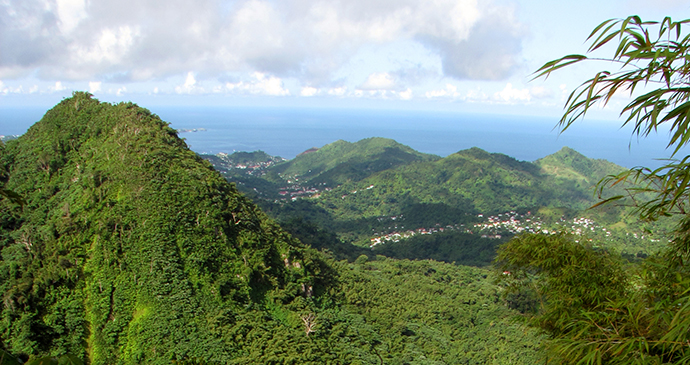
Grand Etang National Park
The Grand Etang National Park was established in 1992. It is a 1,000ha swathe of mountainous forest located in the centre of the island to the northwest of the 1,540ha Grand Etang Forest Reserve that was created as far back as 1906. The name ‘Grand Etang’ is derived from the French meaning ‘large lake’, in reference to the 12ha crater lake which sits at an elevation of 530m at the southeastern boundary of the national park. Also located within the Grand Etang National Park are the summits of Mt Qua Qua, Mt Granby and Morne Fédon (also commonly known as Fédon’s Camp or simply Fédon). Waterfalls found within the park include the three that comprise the Concord Falls – Concord, Au Coin and Fontainbleu. Located on the southwestern perimeter of the park is the frequently visited Annandale Falls.
The mountainous ridges of the national park are steep and narrow. They are home to a variety of trees including gommier (Dacryodes excelsa), a tall gum tree that Amerindians used for making their canoes; mahogany (Swietenia mahagoni); teak (Tectona grandis); balata (Manilkara bidentata); and maruba (Simarouba amara), to name just a few. Prior to Hurricane Ivan in 2004, the tall trees of the Grand Etang National Park and the Grand Etang Forest Reserve provided a high forest canopy that in turn created a wet rainforest habitat on these elevated slopes and ridges.
Unfortunately the high winds of the hurricane had a devastating effect upon the rainforest, particularly on the windward-facing slopes that were exposed to the full force of the storm. The taller trees were either uprooted or cropped by the wind and the result is that there is no longer a high canopy creating wet rainforest conditions. This in turn means that many of the plants, flowers and creatures which you would normally expect to find in Grenada’s rainforest habitat are no longer as prevalent as they once were; in fact some are now quite scarce. Despite the storm, the forest is growing and recovering though it will clearly take many more years to re-establish habitats.
The forests of Grand Etang are also home to the mona monkey (Cercopithecus mona) which was probably introduced to the island from Africa during the years of the slave trade. The monkeys used to be a popular visitor attraction though sightings have become fewer in the wake of two hurricanes. Of particular concern is the destruction of the monkeys’ habitat and the fact that there appears to be little enforcement of the law ensuring their protection from hunters within the national park’s boundaries. Hopefully something will be done about this before the mona monkey goes the way of the agouti (Dasyprocta leporina) and is hunted out of existence in Grenada altogether.
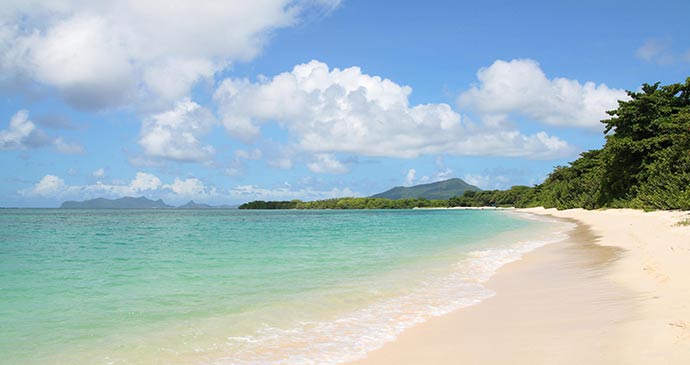
Paradise Beach
L’Esterre’s primary attraction is the stunning Paradise Beach that fringes L’Esterre Bay. Though no beach in Carriacou is ever crowded, in fact most are usually completely deserted, Paradise is conceivably the most popular and where you will actually see other people at play. Locals come here to bathe and have picnics, and private taxis often drop day-trippers here. The beach is white sand with a backdrop of sea almond and grape trees along with the occasional manchineel.
The water is turquoise and shallow along the shore making it ideal for families with young children. As it is protected, the bay attracts very few waves and little current. With colourfully painted fishing boats and water taxis bobbing sedately offshore, the image is one of serenity and relaxation. The trees at the back of the beach offer a degree of shade and there are a number of bars and eateries selling refreshments as well as meals with all the trimmings. Water taxis can be chartered at the Hardwood Bar to take you to the outlying islands.
Sandy Island and its surrounding reef is particularly beautiful and perfect for snorkelling. It has little shade, however, so be prepared and remember that when snorkelling in this climate it is always prudent to do so wearing a T-shirt or a light wetsuit to save the skin on your shoulders and back. Located close to the Hardwood Bar along the roadside is Fidel Productions, selling a selection of unique crafts, mojo jewellery and original T-shirts.
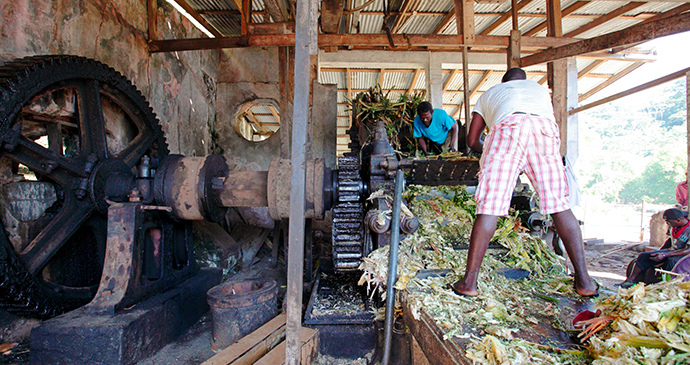
River Antoine Rum Distillery
A visit to the River Antoine Rum Distillery is a must-do for visitors to Grenada. It is an absolutely fascinating glimpse into the past and is certain to enthral anyone interested in the cultural heritage of the region. If you have been hiking and have come across ruins of sugar estates, machine works, waterwheels and cane presses covered in bush and weeds, this experience will bring those discoveries to life.
‘Captain’ Antoine was a Kalinago chief with whom the French settlers sought peace following the series of conflicts leading to the tragic events at Leapers’ Hill in present-day Sauteurs. Chief Antoine’s village was located in the northeast and so a number of places still carry that name today, including River Antoine, Antoine Bay and Lake Antoine. Black Rock, a small islet located in the Atlantic directly east of the mouth of the River Antoine, is also recorded as being originally named Islet d’Antoine by the French.
Constructed in 1785, the distillery claims to have been continuously running since that time, making it unique in the Caribbean. The machinery and the processes of rum production employed by the estate go back to the 18th century, to a period of colonial rule and of course to a time of slavery. The huge waterwheel, some 8m high, is powered by water channelled from the river along an aqueduct and over large wooden paddles.
The wheel in turn drives the machinery, which includes a huge crusher used to extract cane juice. The sugarcane harvested from the 180ha estate is cut and then loaded onto a rickety wooden conveyor that transports it up to the crusher. Workers manhandle the cane, pushing it into the crusher and then reloading it for a second run to ensure all the natural juices have been thoroughly extracted. The residue cane, now pulped and dry, is called bagasse and is used as a fertiliser and mulch for the cane field.
The cane juice is filtered through wicker mats and then ladled by hand along a succession of enormous copper bowls which are heated by a fire below. The juice develops its sugar concentration before being ladled into cooling tanks where it is given time to allow fermentation to begin. Once this has happened, the cane juice is channelled into large tanks where it ferments for about a week before being superheated and distilled. Bottling is a very manual process. The rum is decanted into large plastic drinks coolers and then hand-poured into bottles.
After your tour you will be invited to try some Rivers Rum, either in its neat form or as a blended rum punch. Go steady if you are driving!
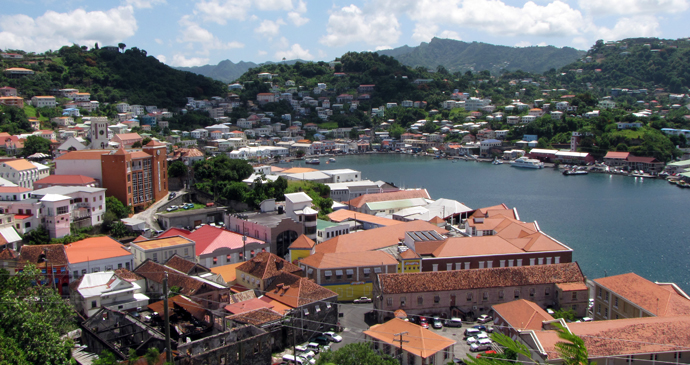
St George’s
Most travel guides, magazines and directories tend to describe Grenada’s capital, St George’s, as one of the prettiest towns in the Caribbean. Whether travellers agree with this sentiment or not, few would dispute that it is certainly very pleasing on the eye. Built around a large natural harbour, the town’s white- and pastel-coloured houses, stone churches, terracotta tiles and galvanised roofs fi ll the hillsides with an exuberance of colour as they rise up from the water’s edge. Add to this the surrounding blue sea, luxury sailing boats at anchor, cruise ships and a verdant backdrop of mountains and lush tropical forest and it is easy to see why most people reach for their cameras when they see this capital for the first time.
Located in the southwest of mainland Grenada at 12°02’N and 61°48’W, St George’s is the administrative centre and major seaport of this tri-island state. The town is constructed around St George’s Harbour, a natural haven that is said to have been carved by a particularly fortuitous burst of volcanic energy. There are two significant areas of the harbour: the Carenage on the northeast side and close to the main town; and the Lagoon, on the southeast side and home of the island’s main port, a large marina development and an anchorage. To the north of the capital is St George’s Bay and several residential areas including Sans Souci and Tempe. To the east of the capital are the high hillside areas of Mt Helicon and Richmond Hill.
To the south of St George’s there are the residential settlements of Paddock, Springs and Belmont. To the south of Belmont is Grand Anse and the southwest peninsula. The capital still bears the odd scar from hurricanes or other misfortunes. Sadly one or two buildings stand in ruin or disrepair, either abandoned or in the process of attempting to raise enough funds for renovation, restoration or, in some cases, a complete rebuild. Despite this, St George’s is a lively place, full of interest, beauty and history. Visitors should be prepared for the hills of the town, some of which are very steep, but which add character and always off er captivating views and scenes of vibrancy and life.
Visitors to St George’s are regular and numerous, thanks to the proximity of the international airport and the cruise-ship berth on the northwest side of town, so Grenadians are very used to seeing their capital even further crowded by an influx of international travellers. They are friendly, welcoming and more than happy to help you out with directions or offer you the chance to purchase their wares. Be sure to engage with the people of this pretty island capital, take your time to walk around and explore, and you will find your visit to St George’s both pleasurable and memorable.
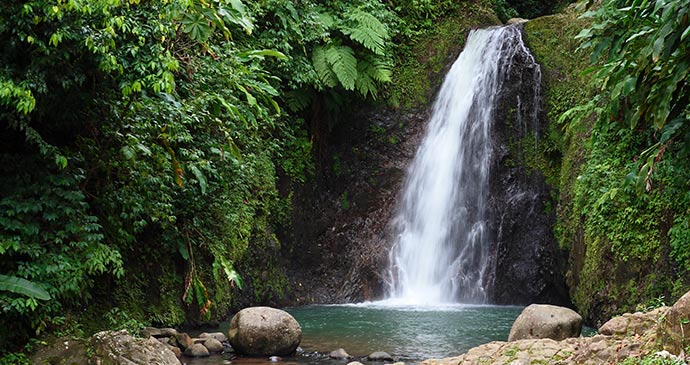
St Margaret’s Falls
This is a moderately easy hike across private estate land to a series of pretty waterfalls with nice, deep and refreshing bathing pools. The trail follows a steep dirt track and can be quite muddy and slippery in places. You also have to hop across rocks to get over a small river to reach the falls right at the end of the trail. The hike takes about 30 to 45 minutes each way. It is downhill there and uphill on the way back. Though the trail is, for the most part, very obvious and clear (it is frequently walked by cruise-ship visitors in the high season), it may be worth taking a guide along to help you out over some of the trickier stretches if you are not a regular hiker. Your guide can also tell you about some of the vegetation you will see along the way, which itself is quite interesting and diverse.
The waterfalls form part of a series known locally as the Seven Sisters. The lower falls are number six, the taller ones above it number five. The four above it are in actual fact rather small cascades that can be accessed via the trail to your right. It takes about 20 minutes to get up to the top and a popular way of descending is simply to jump down each waterfall into the pool below. The seventh waterfall is close by but on a different river. It is called the Honeymoon Falls. The route back to the car park is the same way you came; unfortunately the slippery downhill slopes are now replaced by steep uphill ones. There is currently a planned project to install ropes and zip-lining down all seven waterfalls was being developed as an attraction, especially for cruise-ship visitors.
Related books
For more information, see our guide to Grenada:
Related articles
Author Paul Crask takes us on a walking tour of the beautiful Grenadian capital.
Bianca C is the Caribbean’s largest diveable shipwreck. Nicknamed ‘the Titanic of the Caribbean’, this wreck is an atmospheric and interesting dive.
Author Paul Crask explores enchanting Carriacou in the Southern Grenadines on foot, proving walking is the best method of transport around the island.
Explore beyond the sun loungers on Grenada with these five cultural day trips.
